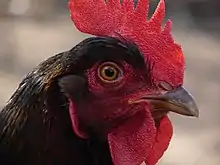Barnevelder
The Barnevelder is a Dutch breed of domestic chicken. It resulted from cross-breeding between local Dutch chickens and various "Shanghai" birds imported from Asia to Europe in the later part of the nineteenth century; these may have been of Brahma, Cochin or Croad Langshan type.[1] It is named for the town and gemeente (municipality) of Barneveld, in Gelderland in the central Netherlands. The hens are good layers of large brown eggs and, unlike some other breeds, continue to lay well during winter.
 | |
| Country of origin | The Netherlands |
|---|---|
| Traits | |
| Weight |
|
| Egg colour | brown |
| Classification | |
| APA | continental[2] |
| EE | yes[3] |
| PCGB | soft feather: heavy[4] |
| |
History



In the 1850s Asian chickens began to arrive in Europe, where they were at first known as "Shanghai" chickens. These were initially cross-bred among themselves, and only later developed into breeds such as the Brahma, the Cochin and the Croad Langshan.[1] From about 1865, some of these Shanghai chickens were cross-bred with local farmyard chickens in the area of Barneveld. Towards the end of the nineteenth century there may also have been some breeding with a type called Amerikaanse Nuthoenders ("American utility birds"), which showed some similarity to the American Wyandotte;[5] it is not known what these birds were, or if they were really American.[1] In about 1906 there may also have been some cross-breeding with British Buff Orpington stock.[6]:99 According to Hans Schippers, the greatest influence on the characteristics of the Barnevelder was from the Langshan, which contributed hardiness, brown eggs, and good winter production.[5]
The name Barnevelder was first used for birds shown at the Landbouwtentoonstelling or agricultural exhibition held in The Hague in 1911.[7]:164 From about this time attempts were made to breed for consistent type and colour.[6]:100 However, when the Dutch Poultry Club discussed whether to accept the Barnevelder as a new breed in 1919, it was found to be too variable.[8]:105 In 1921 a breeders' association was formed, and the first standard was drawn up. The breed was recognised in 1923.[1]
From about 1921 the Barnevelder was exported to the United Kingdom, where brown eggs were in demand. The birds were at first very variable, with single-laced, double-laced or – mostly – partridge plumage. Partridge and double-laced varieties were included in the British Poultry Standard; the double-laced became the principal variety.[9]:62 There may have been some cross-breeding with Indian Game stock.[10] The partridge variety was added to the Standard of Perfection of the American Poultry Association in 1991.[2]
Characteristics
The original and most well-known Barnevelder variety is the double-laced variety, which has a single vertical comb and yellow legs, but other varieties also exist. In standard-sized birds, the pattern is expressed on a brown (e^b/e^b) background.[11] Only the females express the double-laced pattern, whereas the males are melanized black-breasted reds. The Barnevelder Club of the Netherlands recognizes the double-laced, double-laced blue, black, and white varieties in both large fowl and bantam versions.[12] The club also recognizes the silver double-laced variety, but only the bantam version. They note that a few new varieties, such as the silver-black double-laced, are in development but are not yet officially recognised.[13]
Some countries recognize varieties not recognised in the Netherlands, such as the autosexing barred, dark brown, partridge, chamois, blue, and silver varieties.[14][15][16][17]
Use
A Barnevelder hen lays some 175–200 brown eggs per year, with a weight of about 60–65 g.[1]:12
References
| Wikimedia Commons has media related to Barnevelder. |
- Elly Vogelaar (2013). Barnevelders. Aviculture Europe 9 (1) (February 2013). Accessed April 2017.
- APA recognised Breeds and Varieties: As of January 1, 2012. American Poultry Association. Archived 4 November 2017.
- Liste des races et variétés homologuée dans les pays EE (28.04.2013). Entente Européenne d’Aviculture et de Cuniculture. Archived 16 June 2013.
- Breed Classification. Poultry Club of Great Britain. Archived 12 June 2018.
- Hans L. Schippers (2004) Barnevelder Kippen. 144 pp. Netherlands. ISBN 90-901301-4-4 (Dutch language with English and German summaries)
- P. L. Wijk, P. Ubbels (1931): The Origin of the Barnevelder and Welsummer Breeds; and Some Egg Production Figures of the Principal Dutch Utility Breeds. In: Percy A. Francis (1931). Report of Proceedings of the 4th World’s Poultry Congress at the Crystal Palace, London, England, July 22–30, 1930. London: His Majesty’s Stationery Office.
- Johan Schot (2000). Techniek in Nederland in de twintigste eeuw. III, Landbouw, voeding (in Dutch). Eindhoven: Stichting Historie der Techniek. ISBN 9789057300660.
- Bert Mombarg (2000). Houden van kippen: een historisch-sociologische analyse van de georganiseerde raspluimveeteelt (in Dutch). Assen: Uitgeverij Van Gorcum. ISBN 9789023236603.
- Victoria Roberts (2008). British poultry standards: complete specifications and judging points of all standardized breeds and varieties of poultry as compiled by the specialist breed clubs and recognised by the Poultry Club of Great Britain. Oxford: Blackwell. ISBN 9781405156424.
- Joseph Batty (1999) Barnevelder Fowl - History and Management of This Popular Breed Which Lays Deep Brown Eggs, 112 pp, Paperback, Beech Publishing House. ISBN 1-85736-353-1
- ""Carefoot WC"[Author] - PubMed - NCBI". Ncbi.nlm.nih.gov. 2012-01-09. Retrieved 2012-02-19.
- Introductie (in Dutch). Barnevelderclub. Archived 7 March 2017.
- De Vereniging (in Dutch). Barnevelderclub. Archived 7 March 2017.
- "Core Historical Literature of Agriculture". Chla.library.cornell.edu. Retrieved 2012-02-19.
- Archived September 27, 2007, at the Wayback Machine
- http://www.aviculture-europe.nl/nummers/09E03A14.pdf
- "Barnevelder nu ook in zilver-zwart dubbel gezoomd - Levende Have". www.levendehave.nl. Archived from the original on 2014-04-07. Retrieved 2014-04-04.
Further reading
- Barnevelder und Zwerg-Barnevelder Schriftenreihe für Geflügelkunde, 4. Aufl., 48 pp, Verlag Reutlingen Oertel & Spoerer 1989, ISBN 3-88627-078-5 (German language)